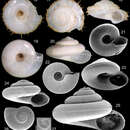Description
provided by Zookeys
Shell. Up to ~2.5 mm, discoid (Figs 18, 24) to trochiform (Figs 20, 25); height ~57-68% of maximum width (Figs 18, 20, 24, 25). Color white, weakly translucent (Figs 16–20). Protoconch of 1 whorl, ~90 µm, weakly-turbiform (Figs 26, 27); whorl of rounded profile, suture shallow; surface glossy, smooth; occupying ~7% of shell size; located almost central, weakly dislocated towards right (Fig. 17). Transition protoconch-teleoconch clear, orthocline (Figs 26, 27). Spire dome-shaped to elevated, with ~66% of shell width; ~60–64% of shell height. Teleoconch up to 4 whorls, uniformly growing inferiorly; last whorl with rounded profile, lacking peripheral carina. Sculpture practically absent, except for growth lines looking undulations and aligned set of small pustules located just superiorly to suture and in middle level of past whorl periphery; each pustule rounded, separated from neighboring pustules by space equivalent to half its width; 2 to 4 equidistant, very weak spiral cords present in ~50% of specimens located in superior region of each whorl (Figs 20, 25); inferior region of body whorl only with growth lines (Figs 19, 22). Umbilicum widely opened; maximum diameter ~30% shell width; flanking by strong, somewhat planar slope, beating only growth lines; weak angulation marking periphery of umbilicum (Figs 19, 23, 24, 25). Aperture slightly prosocline (Figs 21, 22, 23); elliptical (longer axis vertical) (Figs 24, 25); with ~36% shell width, ~40–43% of shell height. Callus practically absent, weakly covering adjacent whorl in apertural implantation (Figs 21, 23).
Periostracum (Figs 16–18). Opaque, transparent, color yellowish beige (Figs 16–18). Three series of rods running on periphery (Fig. 18); central fringe running on pustule lines; other 2 fringes running above and below central fringe, distance between fringes equivalent to ~1/3 of whorl height; periostracum rods located on fringes not uniformly distributed and sized; longer rods extending ~10% shell width, weakly coiled, distantly separated from neighbor rods.
Measurements (in mm). Holotype (Fig. 18): 2.0 by 1.1; paratypes MZSP 106556 (Fig. 20)#1: 2.2 by 1.3; (Fig. 24)#5: 2.6 by 1.5; (Fig. 25)#4: 2.5 by 1.6.
- license
- cc-by-3.0
- copyright
- Luiz Ricardo L. Simone
- bibliographic citation
- Simone L (2012) Two new species of Tornidae (Caenogastropoda, Rissooidea) from Espírito Santo, Brazil ZooKeys 238: 77–85
- author
- Luiz Ricardo L. Simone
Distribution
provided by Zookeys
Brazil, from Bahia to São Paulo.
- license
- cc-by-3.0
- copyright
- Luiz Ricardo L. Simone
- bibliographic citation
- Simone L (2012) Two new species of Tornidae (Caenogastropoda, Rissooidea) from Espírito Santo, Brazil ZooKeys 238: 77–85
- author
- Luiz Ricardo L. Simone

